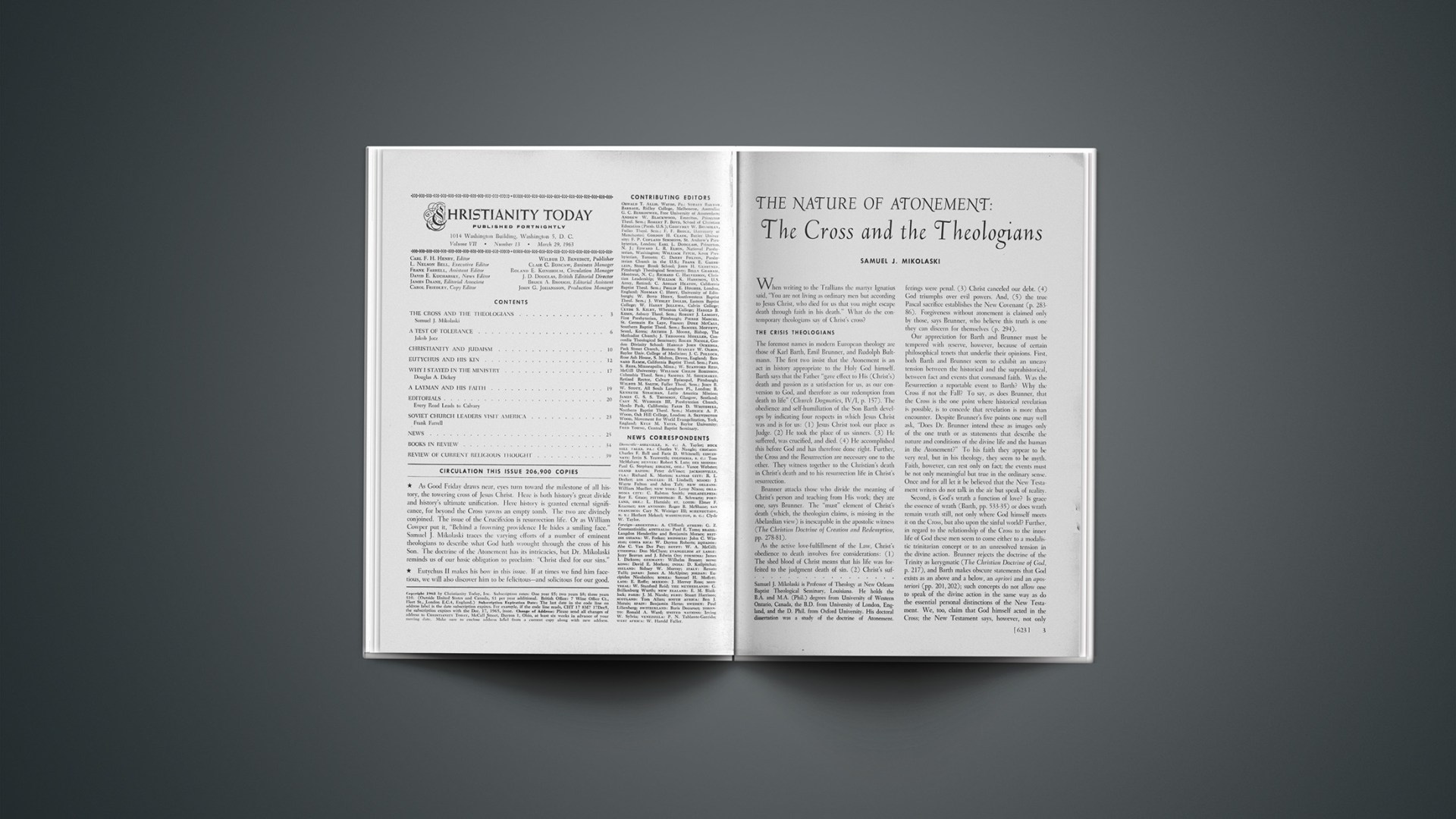When writing to the Trallians the martyr Ignatius said, “You are not living as ordinary men but according to Jesus Christ, who died for us that you might escape death through faith in his death.” What do the contemporary theologians say of Christ’s cross?
The Crisis Theologians
The foremost names in modern European theology are those of Karl Barth, Emil Brunner, and Rudolph Bultmann. The first two insist that the Atonement is an act in history appropriate to the Holy God himself. Barth says that the Father “gave effect to His (Christ’s) death and passion as a satisfaction for us, as our conversion to God, and therefore as our redemption from death to life” (Church Dogmatics, IV/I, p. 157). The obedience and self-humiliation of the Son Barth develops by indicating four respects in which Jesus Christ was and is for us: (1) Jesus Christ took our place as Judge. (2) He took the place of us sinners. (3) He suffered, was crucified, and died. (4) He accomplished this before God and has therefore done right. Further, the Cross and the Resurrection are necessary one to the other. They witness together to the Christian’s death in Christ’s death and to his resurrection life in Christ’s resurrection.
Brunner attacks those who divide the meaning of Christ’s person and teaching from His work; they are one, says Brunner. The “must” element of Christ’s death (which, the theologian claims, is missing in the Abelardian view) is inescapable in the apostolic witness (The Christian Doctrine of Creation and Redemption, pp. 278–81).
As the active love-fulfillment of the Law, Christ’s obedience to death involves five considerations: (1) The shed blood of Christ means that his life was forfeited to the judgment death of sin. (2) Christ’s sufferings were penal. (3) Christ canceled our debt. (4) God triumphs over evil powers. And, (5) the true Pascal sacrifice establishes the New Covenant (p. 283–86). Forgiveness without atonement is claimed only by those, says Brunner, who believe this truth is one they can discern for themselves (p. 294).
Our appreciation for Barth and Brunner must be tempered with reserve, however, because of certain philosophical tenets that underlie their opinions. First, both Barth and Brunner seem to exhibit an uneasy tension between the historical and the suprahistorical, between fact and events that command faith. Was the Resurrection a reportable event to Barth? Why the Cross if not the Fall? To say, as does Brunner, that the Cross is the one point where historical revelation is possible, is to concede that revelation is more than encounter. Despite Brunner’s five points one may well ask, “Does Dr. Brunner intend these as images only of the one truth or as statements that describe the nature and conditions of the divine life and the human in the Atonement?” To his faith they appear to be very real, but in his theology, they seem to be myth. Faith, however, can rest only on fact; the events must be not only meaningful but true in the ordinary sense. Once and for all let it be believed that the New Testament writers do not talk in the air but speak of reality.
Second, is God’s wrath a function of love? Is grace the essence of wrath (Barth, pp. 533–35) or does wrath remain wrath still, not only where God himself meets it on the Cross, but also upon the sinful world? Further, in regard to the relationship of the Cross to the inner life of God these men seem to come either to a modalistic trinitarian concept or to an unresolved tension in the divine action. Brunner rejects the doctrine of the Trinity as kerygmatic (The Christian Doctrine of God, p. 217), and Barth makes obscure statements that God exists as an above and a below, an apriori and an aposteriori (pp. 201, 202); such concepts do not allow one to speak of the divine action in the same way as do the essential personal distinctions of the New Testament. We, too, claim that God himself acted in the Cross; the New Testament says, however, not only that God came and acted, but that God also sent and gave his Son.
Finally, even aside from the disappointing development of faith’s vitalities (is faith not more than venturesome leap and genuine but comforted despair?) one senses an incongruity between the theological perspective of these men and our situation (the value of their work on the Continent notwithstanding). The English-speaking tradition has been blessed by theologians whom Barth and Brunner seem not to have known. (Brunner shows touches of Forsyth, however, who apparently influenced the young Swiss during his two-year stay in England.) Forsyth had developed the cosmic relevance of the Atonement more fully prior to the work of either Barth or Brunner. Barth’s concept of Judge and Judged had been strongly urged by R. W. Dale in The Atonement (1875), a book that went through 22 editions and enjoyed an enormous circulation; Dale also had probed the moral implications of the atoning act. Who can read Barth on substitution without recalling the brilliant exposition of Dr. Denney in The Death of Christ (1902) where, too, on 2 Corinthians 5:14 he develops far more richly than Barth the concept that we died in the death of Christ, that the Cross achieves something specific that changes the situation created by evil and sin? Moreover, one senses in the English writers a more realistic handling of the historical data of the New Testament; in short, they display a basic faith born of fact that seems to have escaped German theology generally since the time of Immanuel Kant.
Rudolph Bultmann, the New Testament scholar, has attracted attention by his attempt to separate the essential Gospel from what is allegedly peripheral to it (the pre-scientific world-view) through a process called Entymythologisierung, or demythologizing. We are not concerned, he says, with certain historical saving events such as the Atonement and the Resurrection (only primitive mythology could construct these) but with a message of saving history attested to in the sacraments and in the present concrete spiritual perfecting of life.
How then do we decide what is myth and what is not? In Jesus and the Word (1958) Bultmann says that Jesus did not come to atone; nor did he come to win forgiveness, but rather to proclaim it. Why then the Cross, we ask? The Church is wrong, he claims, to see “the event, the decisive act of deliverance, in the death of Jesus, or in his death and resurrection,” insofar as they are regarded as “given facts of history which may be determined or established by evidence” (pp. 212, 213). But do not the events and their interpretation stand together in the New Testament? Paul’s “Christ died for our sins” and “we thus judge” are that kind of statement (1 Cor. 15:3; 2 Cor. 5:14). Any explanation, R. W. Dale reminds us, that fails to grasp the necessary connection between the death of Christ and the forgiveness of sins is a grotesque distortion of New Testament doctrine. Bultmann’s basic and prior premise is that no historical event or fact can be the ground of faith or of the highest spiritual reality. Is it possible to dispose of troublesome scriptures so easily? Bultmann’s “events” bear little resemblance to the full-blooded factuality of the New Testament.
A contrasting perspective by the Swedish theologian Anders Nygren (Agape and Eros, 1932–1938) is based on a restudy of love in the New Testament. It restates the “moral influence” theory of Abelard and, more recently, of Hastings Rashdall (The Idea of the Atonement in Christian Theology, 1915) and R. S. Franks (The Atonement, 1934) in Britain, and of Nels F. S. Ferré in this country.
Nygren attempted to demonstrate the theological unity of the New Testament in the concept of agape (spontaneous love) as against that of eros (self-seeking love). As the nature of God, agape “hallmarks the new way of fellowship with God that Christianity brings” (p. 108). Many scholars, however, resist Nygren’s claim that all that the Law stood for in Israel and for Paul is of the flesh. Nygren seems to confuse the “law-works” idea with the Law of God. If God is love he is also holy, we maintain. Thus when he says that “fellowship with God is no longer for Paul a legal relationship, the only question is whether it is a relationship of love,” it may be noted that a love relationship must in that right be moral also. Unless the Cross meets the issue of condemnation we miss the “must” element of Calvary, as Brunner puts it.
Nygren says that “the agape of the Cross” is a “love that gives itself away, that sacrifices itself, even to the uttermost … it is God’s way to man.” Did the agape need this kind of passion for its proof? While claiming this much, objective views have always demanded more as well—divine action dealing with sin, condemnation, and judgment. But this emphasis is totally missing in Nygren. Calvary, as we know, does more than clear up a misunderstanding about the divine love; it is God’s act to save the world and men on the cosmic scale (Rom. 8:22; Col. 1:20–22). Nygren’s view is too anthropocentric. Leonard Hodgson has pointed out that while the moral influence theory has value, it is blind to those effects of sin which operate outside the sinner’s soul.
The Cross And Propitiation
C. H. Dodd has encouraged those who resist the idea that propitiation means averting divine wrath (therefore undercutting the judgment-bearing and substitutionary aspects of the Cross). According to Dodd hilaskesthai and its cognates should read expiation (of sin) and not propitiation (of God). His findings (Journalof Theological Studies, July, 1931; see also Dr. T. W. Manson, Jan.-Apr., 1945) have been widely adopted by theologians on both sides of the Atlantic. Curiously, scholars have been slow to grapple with critics of Dodd’s thesis, notably Leon Morris (The Expository Times, May, 1951; The Apostolic Preaching of the Cross, 1955; The Biblical Doctrine of Judgment, 1960) and Roger Nicole (Westminster Theological Journal, May, 1955), also E. K. Simpson and Professor R. V. G. Tasker.
The theological claim in Dodd’s system is that we cannot think of God as the God of wrath but of love, something which requires close reexamination in the light of what sin must mean to God. The older studies show this clearly; for example, R. W. Dale, The Atonement; James Denney, The Death of Christ; and P. T. Forsyth, The Work of Christ. Denney (as well as Dale, Simpson, and Morris) has said that the idea of propitiation “is not an insulated idea.… It is part of a system of ideas” (pp. 197, 198); therefore such a vital word cannot be applied at will in new ways without jeopardizing the whole of New Testament theology.
The piacular elements of the Atonement together with those that declare the love and grace of God form a unity. What possible attitude can God take to sin but wrath and judgment? There is no meaning to the universe unless its moral structure is reflected in the righteous dealing with sin in the judgment-death of the Cross. The real question is, “If not propitiation then why expiation?”—for if God’s dealing with sin is a reality then this fact is but part and parcel of the prior reality that God’s wrath comes upon both the sinner and his sin. We dare not banish normative morality from the universe. Only if God cares enough to be angry can we say he cares enough to redeem. If someone rejects words like “anger” and “wrath,” let him choose other terms, but maintain the vital realities of the life of God and of the nature of the world.
The Cross As Sacrifice
The foregoing question ought not obscure the “Back to the Bible” movement in recent studies of the Atonement. In broad terms, this movement stresses that Christ made final and indispensable sacrifice for sin. Scholars working with this approach may be grouped for convenience’ sake as follows:
First, those who stress the vicarious element. These include Oliver Quick, Doctrines of the Creed (1938); Vincent Taylor, Jesus and His Sacrifice (1951) and The Cross of Christ (1956); and F. C. N. Hicks, The Fullness of Sacrifice (1938). The moral quality of Christ’s act of self-offering and the power of this vicarious act to forgive, restore, and heal are in view.
A second more recent perspective comes from those who stress the sacramental character of Christ’s sacrifice. The work of Austin Farrer and of Father Lionel Thornton is deeply sensitive here. In America Robert S. Paul (The Atonement and the Sacraments, 1960), a non-conformist, has probed the relation of the Atonement to the Gospel and the sacraments in a manner reminiscent of P. T. Forsyth.
Third, many have emphasized the Cross as the victory over the powers of darkness; this emphasis is due chiefly to the influence of Gustaf Aulen’s Christus Victor (1931), which tried to resurrect a viewpoint held by certain fourth-century Fathers and later by Martin Luther. It should be noted that McLeod Campbell (The Nature of the Atonement) made creative use of this idea over a century ago.
Finally, some have made a vital attempt to recapture the theological realities of the New Testament as seen in A. M. Hunter (The Unity of The New Testament, 1943) and in D. M. Baillie (God Was In Christ, 1948). Christ’s life and death are a unity in Scripture, they urge, and exhibit God’s purpose to redeem. Hunter sums up this unity as follows: “The Atonement originates in the gracious will of God; it has to do with sin; its means is the crucified Christ whose death is vicarious, representative, and sacrificial; and the spiritual end which it secures is reconciliation or renewed fellowship with God based on a forgiveness of sins” (p. 102).
While the value of these studies is great, one senses, first of all, a tendency to distinguish sharply between representation and substitution. Are not both essential to New Testament theology? we would ask. Why does Hunter discuss huper as the “representative” idea, but ignore anti, the term that conveys the idea of “substitution”? We cannot overlook the fact that Christ did something for us as in our place, something that we could not do for ourselves. Further, to interpret “shed blood” as the offerer’s sharing in the life that is released rather than in the victim’s death tends to disallow the piacular elements of the Atonement. The “sharing-in-the-life-released” idea goes back to William Milligan and Bishop Westcott, though they conceded the penal element of the Cross. Surely the point is that our redeemed life can be only the issue of His saving death.
In the case of the victor idea and of the vicarious element we need to investigate more deeply the theological realities involved. What is the victory according to Dr. Aulen? His explanation might suggest that the principalities and powers are myths; if so, the actual nature of the victory remains unidentified. Similarly, what is a vicarious act? How does the vicarious act of one life bear upon that of another as far as forgiveness, reconciliation, and regeneration are concerned?
It is heartening to note the resurgence of interest in New Testament theology. The work of a generation ago, however, like that of Dale, Denney, and Forsyth, bearing as it did upon both the biblical and theological realities, ought still to command our attention. Much of what is being said today was said by them. The recent book by J. S. Whale (Victor and Victim, 1960) is an excellent, evangelically conceived study, but introduces Paul Tillich’s ontology in such a fashion as to undercut freedom rather disappointingly. Mack B. Stokes’s work (The Epic of Revelation, 1961) shows a balance of Bible exposition and philosophical penetration. The Doctrine of the Atonement (1951) by Leonard Hodgson is a noteworthy volume. Hodgson says that as an objective work, the Atonement deals with evil and sin as radical surd elements of the world. The law is the very condition of personal, moral life; thus the Atonement as God’s act vindicates righteousness and judges the evil. God aims to fashion in creation and to win by redemption a race of free human beings who voluntarily out of love seek and do the will of God expressed in Jesus Christ through the power of the Holy Spirit.
No verbal cure for evil and sin can suffice, nor can any solution that does not take seriously the predicament of sinful men under the wrath of God. As the act of God, the Atonement stands in logical relation to the Incarnation (which is how Christ’s work is relevant to us) and to the Trinity (which is the life to which we are called). We must accept and comprehend, therefore, the double reality that God sent his Son and that God was in Christ reconciling the world to himself. This double reality is what the biblical images declare—each part as an insight generated by the truth contributes to the unity of the whole, namely, that the Cross is the issue of the love of God accomplishing redemption. Certainly it is true that Christ sacrificed himself for us, that he died the death of sin, that he made satisfaction for sin expiating it, that he was the propitiation tor sin, that he died as the substitute for sinners and as the representative of the race, that his blood is the precious ransom price of our salvation that seals the covenant of grace. We need to comprehend these concepts in their bearing on the life of the triune God and upon the race.
Despite the intricacies of the doctrine of the Atonement, that the straightforward preaching of the Cross has the power to save men (1 Cor. 1:18) should be central to faith and theology. Seminarians have the curious habit of studying the Atonement comparatively, like some problem in logic, and sometimes forget to make the Cross the vital spiritual datum that it was to New Testament Christians. Our profession is not that of theological cowboys who rope ideas into theological stalls; rather we are to herald the apostolically interpreted fact that “Christ died for our sins.” Happy is he who believes and has the forgiveness God won for mankind through Jesus Christ the Lord.
END










